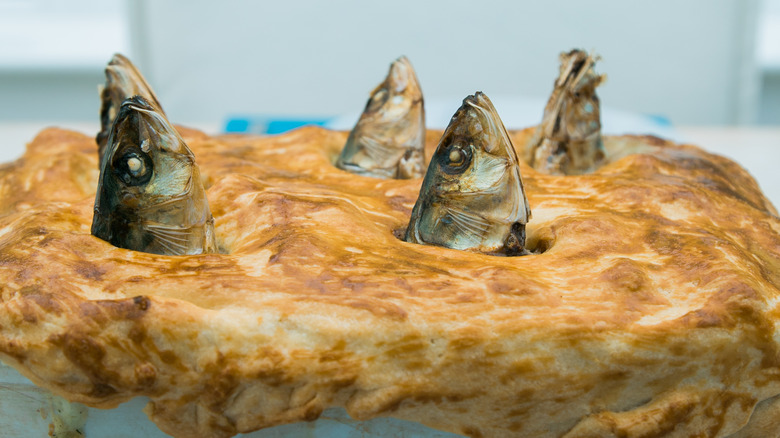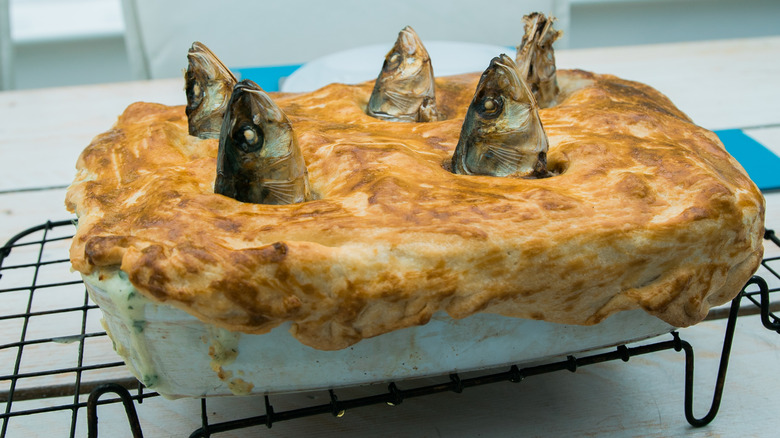English Stargazy Pie Looks Like A Relic Of Medieval Times
When it comes to food, appearances matter, a lot. Sight is often the first sense we use to engage with food. We can be drawn into or turned away from foods just by the way they look. But what happens when the food looks back at you?
Whole fish is often served with its eyes intact — in fact, fish eyes are a signal of freshness — forcing us to face the animal we're about to devour. For some, it's eerie, for others, entertaining, and some even seek fish eyes out as a delicacy. If you're not shy about making eye contact with your dinner, you might be a fan of stargazy pie. It's a very visually striking food because the pie has fish heads (and sometimes tails) sticking out of the crust. Pointing skyward, the fish seem to gaze towards the heavens, hence the dish's name — also spelled as "stargazey pie" and "starry gazey pie".
It looks like it belongs on the table of a medieval warlord, and indeed, it's a dish that harkens back to a far-off era in European history. Although rarely served anymore, stargazy pie is still part of some English traditions. In particular, it's served annually in the tiny village of Mousehole, in England's Cornwall County (where it's said the dish originated) on December 23 as part of a celebration known as Tom Bawcock's Eve which honors a local folk hero.
The tale of Tom Bawcock
The legend goes that stargazy pie was created by a 16th-century Mousehole resident named Tom Bawcock. Like many of the village's residents, Bawcock was a fisherman, but when the people faced a dire threat, he proved his mettle where others could not. According to the story, as described by BBC, a terrible spate of stormy weather forced all the fishing boats to stay in the village harbor. Weeks went by, and the people began to starve, until finally, on the day before Christmas Eve, Tom Bawcock threw caution to the wind and set out to sea with only his cat for company. Despite the grim conditions, Tom Bawcock returned to Mousehole with enough fish to feed the whole town — seven different species, it's said. The villagers were overjoyed, and baked a huge pie with all seven types of fish, leaving some of their heads poking through the crust. It was the first stargazy pie.
As with most folklore, it's doubtful that Tom Bawcock's story is true, and in fact, one Mousehole resident interviewed by Vice in 2017 says that his wife, Dorothy Guard, invented stargazy pie in the 1960s to serve at the Ship Inn, a centuries-old establishment that now serves free stargazy pies to the public on December 23 or Tom Bawcock's Eve, according to Great Big Story. On that night, Mousehole fills with holiday lights, music, and the smell of freshly baked pies.
The basics of stargazy pie
Understandably, the prominent presence of fish heads tends to overshadow the other ingredients of stargazy pie, but there's a lot more to it than that. The most famous iteration, the one made at the Ship Inn, begins with six types of white fish, filleted and baked with herbs. To this, they add grated hard boiled eggs, mashed potatoes, and cream. The mixture is placed in a baking dish and covered with a pastry crust. Then comes the showstopper: the seventh type of fish. This time, it's whole pilchards tucked just beneath the crust, with holes cut in the pastry for their heads to poke through. Sometimes, the tails of the fish are also made to protrude.
"What's a pilchard?" you might ask. Well, there's a chance you've already tried one under a different name: sardines. The term sardine refers to any member of the herring family when they are canned in oil. A pilchard commonly refers to the European pilchard, which lives in large numbers along Europe's coastlines and are particularly abundant in the waters off of Cornwall, according to The Independent. Pilchards are exceptionally oily fish, and oil plays a particularly important role in stargazy pie. Since the pilchards are placed at the very top of the pie, their bodies nestled just below the crust, their oil ends up seeping down into the other ingredients while the pie bakes, infusing the whole dish with flavor.
The result is a hearty dish with a salty, buttery flavor, which is milder than you might expect. The subtle fishy flavor is certainly a stark contrast to stargazy pie's striking appearance.


